2012 Polaris 600 Switchback Review
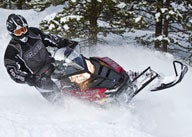
A crossover well suited for trails and some occasional off-trail excursions
If you read our review of the 2012 Polaris 800 Switchback back in August, you probably figure that there isn’t much left to say about the smaller displacement 600cc version other than it has a less powerful, smaller displacement motor. And, you’d be pretty much right.
Engine Type:Horizontal In-line
Cylinders:2
Engine Stroke:2-Stroke
Valve Configuration:Reed Valve
Displacement:599 / 36.6
Starter:Pull
Turbocharged:No
View Full SpecHowever, while we’d be lying through our tuque if we said we’d prefer the 600 Switchback versus the 800 version, there is a definite market for the 600. First of all, this sled is a sweetheart on the trail. Don’t forget that it has adequate punch with its120-plus horsepower. It will probably give you better fuel economy as we’ve always tended to be very heavy-thumbed with the 800s that we’ve ridden. The 600 won’t tease your ego like an 800. But it will be very, very satisfactory for everyday trail riding.
At 599cc the smaller Liberty engine measures 77.25mm by 64mm for bore and stroke. This latest 600 Polaris twin upholds the reputation for reliability and ease of operation that previous Polaris smallish twins earned. Of course, back in the day, a 600cc twin cylinder certainly was not a small motor. Of course, back then Polaris utilized all kinds of power plants from a 250cc single to a 340cc twin to a 500cc triple and upwards to the nearly forgotten 900cc Fusion twin.
While Polaris and Polaris enthusiasts might want to forget the Fusion, there were some good things that came from that experience. For one, it probably led to a much better run and serious engineering group. And, for another, it saw the beginning of Cleanfire Injection. While the trademarked name may sound imposing, it’s really an identifier that tells buyers that the engine has a form of electronic fuel injection (EFI). Since the ill-fated Fusion, late model Polaris Liberty engines have seen some serious engineering going into the Polaris version of EFI. The atomization process and subsequent igniting of the fuel spray has become ever more precise as computerization can dictate precisely when the combustion needs to take place. Modern fuel injection systems rely on sensors that adjust to temperature, altitude, engine revs and so much more. The result is noticed by your throttle thumb and that happy feeling you get when the drive system kicks in.
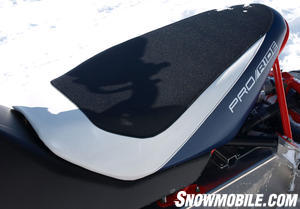 Switchback models feature a Pro-Ride “Adventure” seat with extra length and tapering to the front.
Switchback models feature a Pro-Ride “Adventure” seat with extra length and tapering to the front.
Polaris’ 2012 Liberty 600 twin remains effective and on par with the best 120-hp class engines in snowmobiling. While it may not be as sophisticated as the Rotax E-TEC 600 motor, the Liberty twin will match the Ski-Doo 600s on the trail. Although the latest Yamaha Vector one-liter with fuel injection may be a bit more tractable at drive-off performance than all of the 600cc two-strokes, both the E-TEC and Polaris Cleanfire provide a sensual zippiness from mid-range on up that the Yamaha four-stroke does not.
Polaris’ 600-engined trail sports models remain some of the most enthusiastic performers on the trail. They pull strongly from mid-range and are very good when running through twists and turns on tight trails. The base 600 Rush with the 14-inch shorter track will feel more aggressive on the trail, but the 600 Switchback will be the better answer for traveling less than perfect groomed trails where the 136-inch track length gives you more grip and a definite up tick in bridging those niggling small stutter bumps.
Your overall riding experience will be similar to that of the 800 Switchback on the trail, but since the power levels are quite different, you will find that the power edge for exploring off trail goes to the 800-engined version. But there are really never all encompassing always in off-trail travel. In some snow conditions, the power of the 600 may be an asset. We would think that in certain bottomless snow off-trail conditions where steady flotation is a need, the 600 might work better.
The 600 and 800 versions of the basic Switchback share a similar chassis and suspension set up. The final suspension, shock tuning and, of course, power delivery will differ due to the difference in engine characteristics and overall performance capability. Still, the Switchbacks share similar pieces.
Under the hood, the 600 Liberty twin gets the same basic P85 drive clutch as the 800cc version. The less potent 600 lives with Polaris’ P2 secondary, while the 800 models come with a TEAM secondary drive.
The suspension systems will offer more basic shock packages front and rear. To get the premium Walker Evans shocks, you’d have to upgrade to the 600 Switchback Pro-R, which would run US$700 more. The base 600 Switchback comes with very good Fox gas shocks equipped with an internal floating piston. While you get impressive tuning capability with the Walker Evans units, most snowmobilers will be satisfied with the Fox set up as they are tuned for comfort but still give you good fade resistance. The same applies to the rear suspension as it comes fit with Fox shocks on the front and rear arms. Most tuning comes from the large coil spring outside the suspension skid. But, once you find your happy spot, you’ll most likely leave it alone and just ride.
The Pro-Ride suspensions offer up to 9-inches of front travel and up to 14-inches at the rear. Those are the same numbers you’d get with the more expensive Pro-R.
One major difference between the two Switchback series is the track. The Pro-R gets a Cobra design with a taller 1.352-inch lug height. The standard Switchback features the ubiquitous Ripsaw with a 1.25-inch profile. Otherwise the two tracks measure the same 15-inches across with a 136-inch overall length.
We remain ambivalent about the Pro-R as, yes, we like the premium pieces, but we have found that the base models ride better out of the box. Please, don’t misunderstand. We can get a ride tuned to our exact wants with the Walker Evans equipped Pro-R models, but for everyday riding where we absolutely don’t want to fiddle with settings, the plain Jane Switchback version works extremely well. Polaris engineering seems to work extra hard at finding a just right riding set-up for the base model. Plus, the Fox base shocks are still very good.
You’ll find that the 600 Switchback fits very well as it enjoys a stretched chassis that gives more back-and-forth saddle room for cruising or moving forward to attack moguls. After we’d ridden the test Switchbacks for a while, we found ourselves seeking out and attacking finger drifts and those trail side ridges left from grooming. The sled is extremely rider-friendly in the way of the original Indys. Fortunately for some of us, those old Indys were nearly impervious to idiot maneuvers and could be relied upon to fly straight and flat even when a rider hit a bump all-wrong. The newest Switchbacks carry on that tradition, tending to make their riders better than they might be.
The Switchback proved very comfortable to ride. The raised and tapered seat may seem a bit hard at first, but it helps to position you for bumps or corners. The handlebars fit well, but as always, we prefer the Arctic Cat and Yamaha designs more. Still, for fast running through rough terrain the combination of tallish bar, aggressive seating and roomy footboards make this a very pleasant sled.
With the Switchback you tend to take its standard features for granted. The hand and thumb warmer controls are always convenient to adjust with nary a look-down to check a setting. The electronic reverse you use when backing off a trailer seems second nature. About the only thing we can find fault with is a seeming lack of storage. But, then, your Polaris dealer will happily sell you a tunnel bag.
Overall, the 600 Switchback has to rate as one of the most pleasant all-around sleds for 2012. It’s not so much a star in any one role, but when taken in its entirety, this sled works very well. After all, it is the basis for the all-new Polaris Switchback Adventure. Shed the bags and “extras” of the Adventure and you are left with a 2012 600 Switchback.
| 2012 Polaris 600 Switchback Specs | |
| Engine | Polaris Liberty Cleanfire 599cc twin cylinder 2-stroke; liquid-cooled; Cleanfire fuel injection |
| Horsepower | 120-plus |
| Drive | Polaris P-85 drive; P2 Driven |
| Front Suspension | Polaris Pro-Ride (race-inspired & new for 2012); up to 9-in travel; Fox gas shocks with internal floating piston |
| Rear Suspension | Polaris Pro-Ride slide rail 136-in; Fox gas shock with internal floating piston on front and rear arm; 14-inch travel |
| Length | 115.0 in |
| Width | 48.0 in |
| Height | 46.0 in |
| Ski Stance | 42.5 in |
| Track | 15 x 136 x 1.25 RipSaw |
| Weight | 489 (claimed) |
| Brake | Polaris Phantom hydraulic disc |
| Fuel Capacity | 11.0 US Gal |
| Features | Electronic reverse (PERC); handlebar hook ends; multi-function digital display; electric start option; lock & ride optional luggage and rack |
| MSRP | US$10,299 – C$11,399 |
Related Reading
2012 Polaris Switchback Adventure 600 Review [Video]
2012 Polaris 800 Switchback Review
2012 Polaris 800 Switchback Pro-R Review [Video]



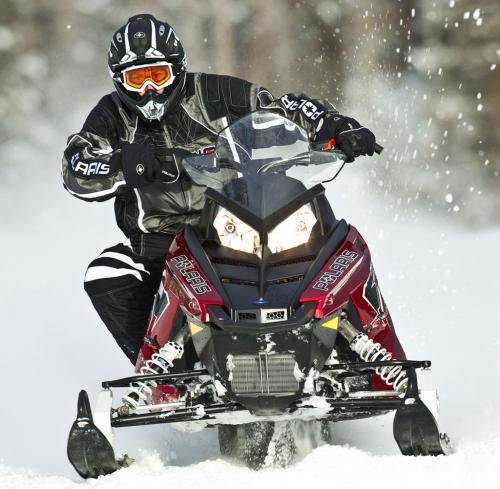
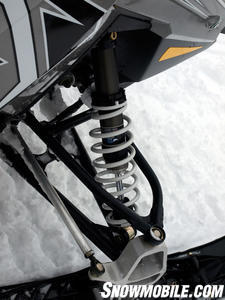
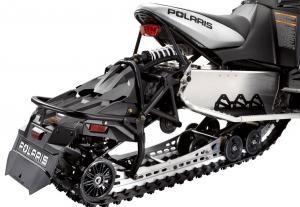
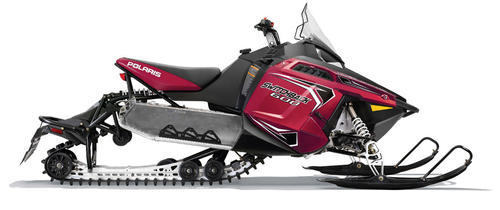
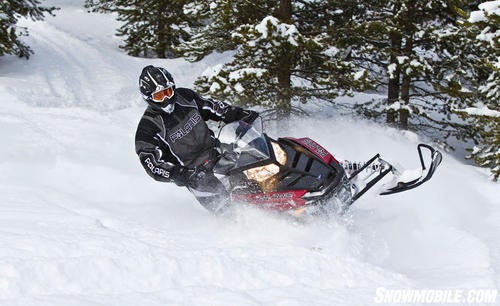

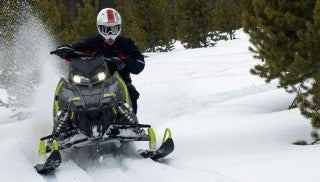



 Your Privacy Choices
Your Privacy Choices